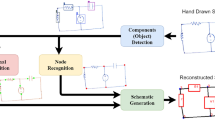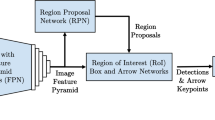Abstract
Over the years companies have accumulated large amounts of legacy data. With modern data mining and machine learning techniques the data is increasingly valuable. Therefore being able to convert legacy data into a computer understandable form is important. In this work, we investigate how to convert schematic diagrams, such as process and instrumentation diagrams (P&I diagrams). We use modern machine learning based approaches, in particular, the Yolo neural network system, to detect high-level objects, e.g. pumps or valves, in diagrams which are scanned from paper archives or stored in pixel or vector form. Together with connection detection and OCR this is an essential step for the reuse of old planning data. Our results show that Yolo, as an instance of modern machine learning based object detection systems, works well with schematic diagrams. In our concept, we use a simulator to automatically generate labeled training material to the system. We then retrain a previously trained network to detect the components of our interest. Detection of large components is accurate but small components with sizes below 15% of page size are missed. However, this can be worked around by dividing a big diagram into a set of smaller subdiagrams with different scales, processing them separately, and combining the results.
Access this chapter
Tax calculation will be finalised at checkout
Purchases are for personal use only
Similar content being viewed by others
Notes
References
Ablameyko SV, Uchida S (2007) Recognition of engineering drawing entities: review of approaches. Int J Image Graph 07(04):709–733. https://doi.org/10.1142/S0219467807002878
Adam S, Ogier J, Cariou C, Mullot R, Labiche J, Gardes J (2000) Symbol and character recognition: application to engineering drawings. Int J Doc Anal Recogn 3(2):89–101. https://doi.org/10.1007/s100320000033
Arroyo E, Hoernicke M, Rodríguez P, Fay A (2016) Automatic derivation of qualitative plant simulation models from legacy piping and instrumentation diagrams. Comput Chem Eng 92:112–132
Bodic PL, Locteau H, Adam S, Héroux P, Lecourtier Y, Knippel A (2009) Symbol detection using region adjacency graphs and integer linear programming. In: 2009 10th international conference on document analysis and recognition. IEEE, pp 1320–1324. https://doi.org/10.1109/ICDAR.2009.202. http://ieeexplore.ieee.org/document/5277721/
Cordella L, Vento M (2000) Symbol recognition in documents: a collection of techniques? Int J Docu Anal Recogn 3(2):73–88. https://doi.org/10.1007/s100320000036
De P, Mandal S, Das A, Bhowmick P (2014) A new approach to detect and classify graphic primitives in engineering drawings. In: 2014 fourth international conference of emerging applications of information technology. IEEE, pp 243–248. https://doi.org/10.1109/EAIT.2014.33. http://ieeexplore.ieee.org/document/7052053/
Henderson TC (2014) Analysis of engineering drawings and raster map images. Springer
Huang J, Rathod V, Sun C, Zhu M, Korattikara A, Fathi A, Fischer I, Wojna Z, Song Y, Guadarrama S et al (2017) Speed/accuracy trade-offs for modern convolutional object detectors. In: IEEE CVPR, vol 4
Hui J (2018) Object detection: speed and accuracy comparison (faster R-CNN, R-FCN, SSD, FPN, RetinaNet and YOLOv3). https://medium.com/@jonathan_hui/object-detection-speed-and-accuracy-comparison-faster-r-cnn-r-fcn-ssd-and-yolo-5425656ae359/
Jin L, Zhou Z, Xiong S, Chen Y, Liu M (1998) Practical technique in conversion of engineering drawings to CAD form. In: IMTC/98 conference proceedings. IEEE instrumentation and measurement technology conference. Where instrumentation is going (Cat. No. 98CH36222) 1:8–13. https://doi.org/10.1109/IMTC.1998.679631. http://ieeexplore.ieee.org/document/679631/
Song J, Su F, Tai C-L, Cai S (2002) An object-oriented progressive-simplification-based vectorization system for engineering drawings: model, algorithm, and performance. IEEE Trans Pattern Anal Mach Intell 24(8):1048–1060. https://doi.org/10.1109/TPAMI.2002.1023802. http://ieeexplore.ieee.org/document/1023802/
Karima M, Sadhal K, McNeil T (1985) From paper drawings to computer-aided design. IEEE Comput Graph Appl 5(2):27–39. https://doi.org/10.1109/MCG.1985.276400. http://ieeexplore.ieee.org/document/4056067/
Kasturi R, Bow S, El-Masri W, Shah J, Gattiker J, Mokate U (1990) A system for interpretation of line drawings. IEEE Trans Pattern Anal Mach Intell 12(10):978–992. https://doi.org/10.1109/34.58870. http://ieeexplore.ieee.org/document/58870/
Liu L, Ouyang W, Wang X, Fieguth P, Chen J, Liu X, Pietikäinen M (2018) Deep learning for generic object detection: a survey. arXiv preprint arXiv:1809.02165
Meng Z, Fan X, Chen X, Chen M, Tong Y (2017) Detecting small signs from large images. In: 2017 IEEE international conference on information reuse and integration (IRI). IEEE, pp 217–224
Pan SJ, Yang Q et al (2010) A survey on transfer learning. IEEE Trans Knowl Data Eng 22(10):1345–1359
Redmon J, Farhadi A (2018) YOLOv3: an incremental improvement. arXiv
Roth PM, Winter M (2008) Survey of appearance-based methods for object recognition. Inst. for Computer Graphics and Vision, Graz University of Technology, Austria, Technical report ICGTR0108 (ICG-TR-01/08)
Ruo-yu Y, Feng S, Tong L (2010) Research of the structural-learning-based symbol recognition mechanism for engineering drawings. In: 2010 6th international conference on digital content, multimedia technology and its applications (IDC), pp 346–349
Smith R (2007) An overview of the Tesseract OCR engine. In: Ninth international conference on document analysis and recognition (ICDAR 2007), vol 2. IEEE, pp 629–633. https://doi.org/10.1109/ICDAR.2007.4376991. http://ieeexplore.ieee.org/document/4376991/
Smith R (2007) An overview of the Tesseract OCR engine. In: Ninth international conference on document analysis and recognition, ICDAR 2007, vol 2. IEEE, pp 629–633
Uijlings JR, Van De Sande KE, Gevers T, Smeulders AW (2013) Selective search for object recognition. Int J Comput Vis 104(2):154–171
Author information
Authors and Affiliations
Corresponding author
Editor information
Editors and Affiliations
Rights and permissions
Copyright information
© 2020 Springer Nature Switzerland AG
About this paper
Cite this paper
Nurminen, J.K., Rainio, K., Numminen, JP., Syrjänen, T., Paganus, N., Honkoila, K. (2020). Object Detection in Design Diagrams with Machine Learning. In: Burduk, R., Kurzynski, M., Wozniak, M. (eds) Progress in Computer Recognition Systems. CORES 2019. Advances in Intelligent Systems and Computing, vol 977. Springer, Cham. https://doi.org/10.1007/978-3-030-19738-4_4
Download citation
DOI: https://doi.org/10.1007/978-3-030-19738-4_4
Published:
Publisher Name: Springer, Cham
Print ISBN: 978-3-030-19737-7
Online ISBN: 978-3-030-19738-4
eBook Packages: Intelligent Technologies and RoboticsIntelligent Technologies and Robotics (R0)




